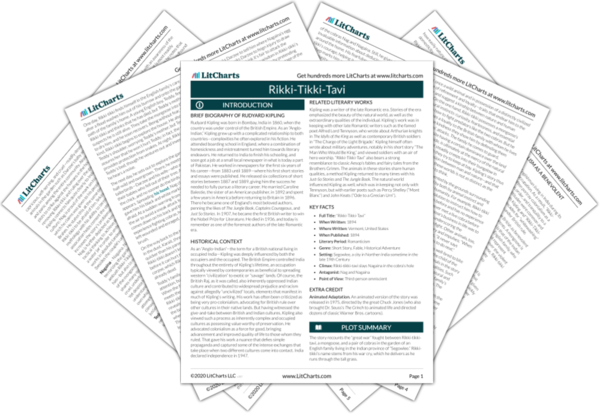Nag draws deliberate attention to his hood—and more importantly the symbol on it—as a gift from the great god Brahm. It marks Nag as representative of India without British rule: dangerous, cruel, and ruling through fear and superstition. Rikki-tikki stands in opposition to that, and fights to rid the garden of the threat represented by the hood. The deliberate connection between the villain and Hindu mythology marks perhaps the most overt expression of colonialist themes in the story: with the heroic British (represented by Rikki-tikki) fighting to claim India from the darkness and savagery of native Indian culture. It’s also one of the reasons why the work is considered so problematic to modern eyes: an attack on Hindu culture from a member of an occupying force.
Indeed, there’s even a bit of savage irony to Nag’s story. It entails an act of selflessness and mercy: the symbol was granted because Nag’s ancestor shielded Brahm from the heat of the sun. Nag tells the story in the wake of eating the tailorbirds’ baby and in the same statement he demands fear from Rikki-tikki. Kipling seems to suggest that, by defying the British order that Rikki-tikki is defending, the cobra is making a mockery of his own Indian heritage.
Nag’s Hood Quotes in Rikki-Tikki-Tavi
Then inch by inch out of the grass rose up the head and spread hood of Nag, the big black cobra, and he was five feet long from tongue to tail. When he had lifted one-third of himself clear of the ground, he stayed balancing to and fro exactly as a dandelion tuft balances in the wind, and he looked at Rikki-tikki with the wicked snake’s eyes that never change their expression, whatever the snake may be thinking of.
“Who is Nag?” said he. “I am Nag. The great God Brahm put his mark upon all our people, when the first cobra spread his hood to keep the sun off Brahm as he slept. Look, and be afraid!”

Unlock explanations and citation info for this and every other Rikki-Tikki-Tavi quote.
Plus so much more...
Get LitCharts A+









